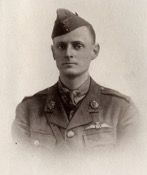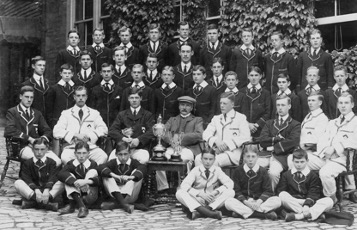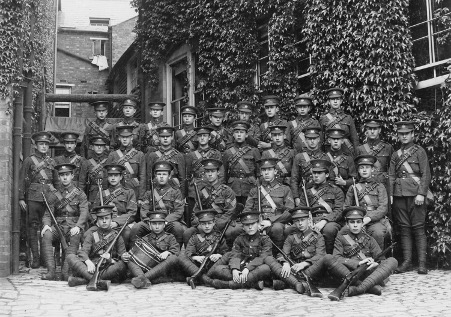Alexander Perceval Matheson

| Rank: | Lieutenant |
| Regiment: | Flying Corps, 55th Squadron |
| Country: | Belgium |
| Cemetary/Memorial: | Audenaarde Communal Cemetery (Row C) |
| Awards: | British War Medal Victory Medal |
Born on 21st January 1895 in Brighton, West Sussex, Lieutenant Matheson was killed in action on 13th July 1917, aged 22, after his plane was shot down over Belgium.
Alexander Perceval Matheson was the youngest son of Sir Alexander Perceval of Lochalsh, 3rd Baronet (1861-1929) and Lady Eleanor Matheson (nee Money, 1864-1959) of Ardarun, Littlehampton, Sussex.
He had two brothers, Ian Kenneth (1893-1917) and Roderick Kyrle (1897-1916) who also served and perished before him in the Great War. He also had four sisters, Margaret Anna (1886-1948), Muriel Helen (1890-1970), Norah (1890-1967) and Eleanor (b.1895).
Like his brothers, Alexander attended Saint Ronan’s in 1903. Whilst his brothers went on to Wellington, Alexander went on to Oundle School, Northamptonshire, entering Dryden House in January 1910.
He was very involved in the workshops and won a Speech Day Prize for his work there in 1910, 1911 and 1912. He sang in the Choral Society in the Bass section.

Dryden House, Oundle, 1910 – Alexander is in the back row, third from right.

Dryden House, 1912, Winning Rugby House Competition - Alexander is in the back row, second from left.
Alexander was a member of the Office Training Corps and the Dryden House Platoon. He represented Dryden House in rugby, cricket and shooting. He was part of the Dryden Rugby Team that won the House Competition in 1912.

Dryden House Platoon, 1912 - Alexander is in the third row, sixth from left.
He had intended to take up engineering as a profession, but upon leaving school, he went out to Canada in February 1914 to take up a four year course in farming and forestry at the Ontario Agricultural College. When war was declared, he returned to Littlehampton, and received a commission in the ASC two weeks after his arrival. In November 1915, he transferred to the Flying Corps and in February 1916 flew with his Squadron (No.55) to France, where he was continually in action from that date until his death. His machine was shot down in a fight over Aerselle, near Oudenarde. He was shot down by the acclaimed fighter pilot, Lieutenant Ernst Hess (a German of Jewish descent who received protection from Nazi persecution), who shot down the DH4 A7421, flown by Lieutenant Matheson alongside Second Lieutenant Frank Lambton Oliver.
At the time of his death he was Lieutenant and Acting Flight Commander, and was described by an Officer as 'One of the bravest and best pilots in the Squadron'.
The following is an account of his death:
"On Friday 13th July 1917, the Albatros' of Jasta 28, where ace Erst Hess was stationed, observed a formation DH-4s which was crossing the French-Belgian border.
The German planes persued them over Oudenaarde but can't catch up with the fast British planes.
The Albatros' climb up to an altitude of 4300 meters and thus obtained an excellent position to intercept the bombers on their way back.
Hess chooses the plane flying to back left of the formation and fires his first volley. To this action the observer/gunner retaliated but it stopped almost immediately as the gunner was hit.
Meanwhile the British pilot tries to evade Hess but a second volley, 100 bullets, pierce the aeroplane.
The British twoseater dives to the ground , breaking of his wings and at the same time the observer falls out of the plane.
The DH-4 with serial number A7421 hits the ground, burning, around 15h.30 between Oudenaarde and Ooike.
The remains of both British were found later that day. The body of the pilot was Lt. Matheson and the observer was 2Lt. Frank Lambton Oliver. Both were buried at the Communal Cemetery where they rest till this day.”
German flying ace, Lieutenant Ernst Hess, obtained that day his third official victory.
Alexander’s brothers also served and sadly perished in the War:
• Ian Kenneth served as a Captain with the Seaforth Highlanders, 2nd Battalion Ross-shire Buffs, The Duke of Albany’s Regiment. He died of his wounds on 13th May 1917. He was 23 years old.
• Roderick Kyrle served as a Second Lieutenant with the Queen’s Own (Royal West Kent Regiment), 3rd Battalion, attached Manchester Regiment, 20th Battalion, 30th Division. He was taken prisoner and died of his wounds at Ginchy in France on 8th September 1916. He was 18 years old.
The brothers are also commemorated on the Littlehampton War Memorial, Sussex.
